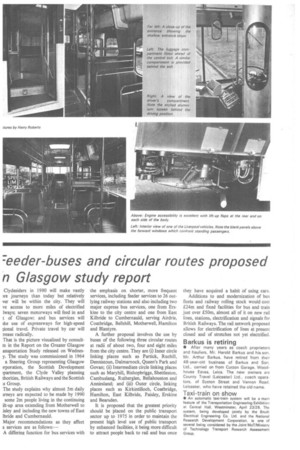7 eeder-buses and circular routes proposed
Page 49

If you've noticed an error in this article please click here to report it so we can fix it.
n Glasgow study report
Clydesiders in 1990 will make vastly re journeys than today but relatively ver will be within the city. They will ye access to more miles of electrified lways; seven motorways will feed in and t of Glasgow; and bus services will tke use of expressways for high-speed ;ional travel. Private travel by car will Tease radically.
That is the picture visualized by consultts in the Report on the Greater Glasgow ansportation Study released on Wednesy. The study was commissioned in 1964 a Steering Group representing Glasgow irporation, the Scottish Development ipartment, the Clyde Valley planning thorities, British Railways and the Scottish .5 Group.
The study explains why almost 5m daily Kneys are expected to be made by 1990 some 2m people living in the continuing ilt-up area extending from Motherwell to isley and including the new towns of East 'bride and Cumbernauld.
Major recommendations as they affect s services are as follows:— A differing function for bus services with the emphasis on shorter, more frequent services, including feeder services to 26 outlying railway stations and also including two major express bus services, one from Erskine to the city centre and one from East Kilbride to Cumbernauld, serving Airdrie, Coatbridge, Bellshill, Motherwell, Hamilton and Blantyre.
A further proposal involves the use by buses of the following three circular routes at radii of about two, four and eight miles from the city centre. They are (i) Inner circle linking places such as Partick, Ruchill, Dennistoun, Dalmarnock, Queen's Park and Govan; (ii) Intermediate circle linking places such as Maryhill, Bishopbriggs, Shettleston, Crunbuslang, Rutherglen, Bellahouston and Anniesland; and (iii) Outer circle, linking places such as Kirkintilloch, Coatbridge, Hamilton, East Kilbride, Paisley, Erskine and Bearsden.
It is proposed that the greatest priority should be placed on the public transport sector up to 1975 in order to maintain the present high level use of public transport by enhanced facilities, it being more difficult to attract people back to rail and bus once they have acquired a habit of using cars.
Additions to and modernization of bus fleets and railway rolling stock would cost £24m and fixed facilities for bus and train just over £50m, almost all of it on new rail lines, stations, electrification and signals for British Railways. The rail network proposed allows for electrification of lines at present closed and of stretches not yet electrified.
Barkus is retiring
• After many years as coach proprietors and hauliers, Mr. Harold Barkus and his son, Mr. Arthur Barkus, have retired from their 48-year-old business of Barkus and Son. Ltd.. carried on from Curzon Garage, Woodhouse Eaves, Leics. The new owners are County Travel (Leicester) Ltd., coach operators, of Syston Street and Vernon Road, Leicester, who have retained the old name.
Taxi-train on show • An automatic taxi-train system will be a main feature of the Transportation Engineering Exhibition at Central Hall. Westminster, April 23/26. The system, being developed jointly by the Brush Electrical Engineering Co. Ltd. and the National Research Development Corporation, is one of several being considered by the Joint MoT/Ministry of Technology Transport Research Assessment Group.








































































































































